
Live media workflows are increasingly using AI microservices to augment production capabilities. However, advanced AI models are mostly hosted in the cloud, making it challenging to process high-bitrate, uncompressed media streams due to constraints around network latency, bandwidth, and real-time scalability. NVIDIA released new AI reference applications that facilitate the ease of AI��
]]>
In the rapidly evolving robotics and edge AI landscape, the ability to efficiently process and transfer sensor data is crucial. Many edge applications are moving away from single-sensor fixed-function solutions and in favor of diverse sensor arrays. These include vision, audio, temperature, force/torque, and communication sensors, IMUs, idaradar systems, ultrasounds, motors, and actuators.
]]>
A researcher from the SETI Institute described to a packed audience at GTC 2025 how SETI had successfully trialed a novel method to identify interstellar radio waves which, theoretically, can also be used to identify communication from intelligent extraterrestrial life. Luigi Cruz, a staff engineer at SETI, the world��s foremost organization looking for signs of intelligent life on other��
]]>
NVIDIA announced at GTC 2025 the release of NVIDIA Holoscan 3.0, the real-time AI sensor processing platform. This latest version provides dynamic flow control, empowering developers to design more robust, scalable, and efficient systems. With physical AI rapidly evolving, Holoscan 3.0 is built to adapt, making it easier than ever to tackle the challenges of today��s dynamic environments.
]]>
NVIDIA Holoscan for Media is an NVIDIA-accelerated platform designed for multi-vendor live production and AI. It will be showcased at GTC, highlighting NVIDIA NIM, AI SDKs, and microservices that enhance live production workflows. Built on Kubernetes, the container orchestration platform simplifies media timing, synchronization, and management through NVIDIA components such as the GPU and��
]]>
Developers in the fields of image-guided surgery and surgical vision face unique challenges in creating systems and applications that can significantly improve surgical workflows. One such challenge is efficiently combining multi-modal imaging data, such as preoperative 3D patient images with intra-operative video. This is key to providing surgeons with real-time��
]]>
NVIDIA Holoscan for Media is now ready to be used in live production, taking advantage of the best of both networking and GPU technologies. Holoscan for Media is a software-defined, AI-enabled platform that enables live video pipelines to run on the same infrastructure as AI. It delivers applications from established and emerging vendors across the ecosystem on repurposable��
]]>
NVIDIA Holoscan for Media is a software-defined, AI-enabled platform that enables live video pipelines to run on the same infrastructure as AI. This video explains how developers in live media can use NVIDIA Holoscan for Media to build and deploy applications as software on repurposable, NVIDIA-accelerated, commercial off-the-shelf hardware. The video features Guillaume Polaillon��
]]>
The demand for real-time insights and autonomous decision-making is growing across industries, and healthcare and medical devices are no exception. Relying on real-time edge AI, the next generation of healthcare promises to deliver more precise treatments, improve patient outcomes, and increase operational efficiencies. Operating rooms of the future, for example��
]]>
NVIDIA Holoscan is the NVIDIA domain-agnostic multimodal real-time AI sensor processing platform that delivers the foundation for developers to build their end-to-end sensor processing pipeline. NVIDIA Holoscan SDK features include: Holoscan SDK can be used to build streaming AI pipelines for a range of industries and use cases, including medical devices, high-performance computing at��
]]>
Real-time AI at the edge is crucial for medical, industrial, and scientific computing because these mission-critical applications require immediate data processing, low latency, and high reliability to ensure timely and accurate decision-making. The challenges involve not only high-bandwidth sensor processing and AI computation on the hardware platform but also the need for enterprise-level AI��
]]>
NVIDIA Holoscan for Media is now available to all developers looking to build next-generation live media applications on fully repurposable clusters. Holoscan for Media is a software-defined platform for building and deploying applications for live media. It revolutionizes application development by providing an IP-based, cloud-native architecture that isn��t constrained by dedicated hardware��
]]>
Edge AI developers are building AI applications and products for safety-critical and regulated use cases. With NVIDIA Holoscan 1.0, these applications can incorporate real-time insights and processing in milliseconds. With the recent release of NVIDIA Holoscan 1.0, developers can more easily build production-ready applications for multimodal, real-time sensor processing.
]]>
NVIDIA Holoscan for Media is a software-defined platform for building and deploying applications for live media. Recent updates introduce a user-friendly developer interface and new capabilities for application deployment to the platform. Holoscan for Media now includes Helm Dashboard, which delivers an intuitive user interface for orchestrating and managing Helm charts.
]]>
As large language models (LLMs) become more powerful and techniques for reducing their computational requirements mature, two compelling questions emerge. First, what is the most advanced LLM that can be run and deployed at the edge? And second, how can real-world applications leverage these advancements? Running a state-of-the-art open-source LLM like Llama 2 70B, even at reduced FP16��
]]>
Diamond Light Source is a world-renowned synchrotron facility in the UK that provides scientists with access to intense beams of x-rays, infrared, and other forms of light to study materials and biological structures. The facility boasts over 30 experimental stations or beamlines, and is home to some of the most advanced and complex scientific research projects in the world. I08-1��
]]>
The broadcast industry is undergoing a transformation in how content is created, managed, distributed, and consumed. This transformation includes a shift from traditional linear workflows bound by fixed-function devices to flexible and hybrid, software-defined systems that enable the future of live streaming. Developers can now apply to join the early access program for NVIDIA Holoscan for��
]]>
Demand for real-time insights and autonomous decision-making is growing in various industries. To meet this demand, we need scalable edge-solution platforms that can effectively process AI-enabled sensor data right at the source and scale out to on-premises or cloud compute resources. However, developers face many challenges in using AI and sensor processing at the edge: Before��
]]>
Edge AI applications, whether in airports, cars, military operations, or hospitals, rely on high-powered sensor streaming applications that enable real-time processing and decision-making. With its latest v0.5 release, the NVIDIA Holoscan SDK is ushering in a new wave of sensor-processing capabilities for the next generation of AI applications at the edge. This release also coincides with the��
]]>
Imagine you are about to embark on the mountain biking adventure of a lifetime. You have done all of the planning and training. Now, all you need is the perfect bike. You need the best shocks, tires, brakes, frame, handlebars, and seat. Imagine that all of these parts would come together in one package, preassembled, saving you time and money. NVIDIA IGX Orin offers a similar package to edge��
]]>
The computational needs for AI processing of sensor streams at the edge are increasingly demanding. Edge devices must keep up with high rates of incoming data streams, processing, displaying, archiving, and streaming results or closing a control loop in real time. This requires powerful, efficient, and accurate hardware and software solutions capable of high performance computing.
]]>
At GTC 2022, NVIDIA introduced enhancements to AI frameworks for building real-time speech AI applications, designing high-performing recommenders at scale, applying AI to cybersecurity challenges, creating AI-powered medical devices, and more. Showcased real-world, end-to-end AI frameworks highlighted the customers and partners leading the way in their industries and domains.
]]>
This post was updated April 2023. Scientific instruments are being upgraded to deliver 10�C100x more sensitivity and resolution over the next decade, requiring a corresponding scale-up for storage and processing. The data produced from these enhanced instruments will reach limits that Moore��s law cannot adequately address and it will challenge traditional operating models solely based on HPC��
]]>